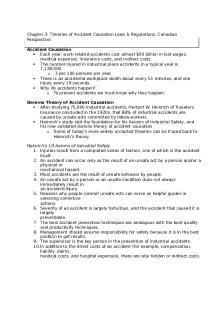Chapter 3 PDF

| Title | Chapter 3 |
|---|---|
| Author | Danielle Hunt |
| Course | Organizational Behaviour |
| Institution | University of Ottawa |
| Pages | 7 |
| File Size | 335.2 KB |
| File Type | |
| Total Downloads | 92 |
| Total Views | 198 |
Summary
Chapter 3 notes...
Description
Chapter 3 Monday, September 14, 2020
6:12 PM
3.1: What is Organizational Commitment? What is Withdrawal Behaviou Connected? - Organizational Commitment: an employees desire to remain a mem - Withdrawal Behaviour: set of actions that employees perform to a
-
3.2: What Are The Three Types of Organizational Commitment, and How Do -
Affective Commitment: a desire to remain a member of an organization attachment to, and involvement with, the organization (want) ○
Employees with fewer bonds are more likely to quit( Erosion Mode
○
Strong correlation between affective commitment and citizenship b
○
Employees with a direct linkage with "leavers" will become more lik Influence Model)
-
Continuance Commitment: desire to remain a member of an organizatio of the costs associated with leaving (need) ○
Associate a profit with staying and a cost with leaving
○
Embeddedness: employees links to their organization and communit the organization and community, and what they would have to sac
-
Normative Commitment: desire to remain a member of an organization obligation (ought)
Organizational Commitment ? How Are The Two
3.4: What Are Some Eg of Psychological Withdrawal? Of Withdrawal? How do They Relate To Each Other? - Psychological Withdrawal: actions that provide a me
er of the organization
from the work environment
oid the work situation
○
Moonlighting: using company resources to comp nonwork related
- Physical Withdrawal: actions that provide a physical whether short-term or long-term from the work en ○
Absenteeism: missing work for a day
- Independent Forms Model: various withdrawal behavi uncorrelated - Compensatory Forms Model: withdrawal behaviours a correlated
They Differ?
- Progression Model: withdrawal behaviours are positiv
due to an emotional
3.5: What Workplace Trends Are Affecting Organizational haviour
Diversity In the work force ○
y to leave (Social
in their current jobs -
because of an awareness
their sense of fit with
reduces commitment if employees feel lower lev
Changing Employee-Employer relationship ○
Brought about by a generation of downsizing
○
Psychological Contracts: employees beliefs about
○
Transactional Contract: monetary obligations
○
Relational Contracts: open-ended and subjective
fice for a job change ue to a feeling of
3.6: How Can Organizations Forster A Sense of Commitm Perceived Organizational Support: the degree to whi
Physical tal escape ete something scape, ironment
w
rs are e negatively ly correlated Commitment In Todays Organizations? s of affective commitment or become less embedded
what they owe the org and what the org owes them bligations ent Among Employees? h an employee believes the org
obligation (ought) 3.3: What Are The Four Primary Responses To Negative Events At Work? - Exit: an active, destructive response where an individual either ends or re - Voice: active, constructive response where individuals attempt to improve - Loyalty: passive, constructive response that maintains public support for - Neglect: passive, destructive response in which interest and effort in the - Organizational commitment increases the likelihood of voice and loyalty w
- Perceived Organizational Support: the degree to whi values their contributions/ well being tricts organisational membership (quits) the situation he situation while individual privately hopes for i ob declines le decreasing the likelihood of exit and neglect
h an employee believes the org...
Similar Free PDFs

Chapter 3 Chapter 3 Chapter 3
- 9 Pages

Chapter 3 - Ch 3
- 13 Pages

3 - chapter 3
- 4 Pages

Chapter 3
- 136 Pages

Chapter 3
- 41 Pages

Chapter 3
- 2 Pages

Chapter 3
- 2 Pages

Chapter 3
- 18 Pages

Chapter 3
- 8 Pages

Chapter 3
- 14 Pages

Chapter 3
- 6 Pages

Chapter 3
- 57 Pages

Chapter 3
- 12 Pages

Chapter 3
- 11 Pages

Chapter 3
- 7 Pages

Chapter 3
- 7 Pages
Popular Institutions
- Tinajero National High School - Annex
- Politeknik Caltex Riau
- Yokohama City University
- SGT University
- University of Al-Qadisiyah
- Divine Word College of Vigan
- Techniek College Rotterdam
- Universidade de Santiago
- Universiti Teknologi MARA Cawangan Johor Kampus Pasir Gudang
- Poltekkes Kemenkes Yogyakarta
- Baguio City National High School
- Colegio san marcos
- preparatoria uno
- Centro de Bachillerato Tecnológico Industrial y de Servicios No. 107
- Dalian Maritime University
- Quang Trung Secondary School
- Colegio Tecnológico en Informática
- Corporación Regional de Educación Superior
- Grupo CEDVA
- Dar Al Uloom University
- Centro de Estudios Preuniversitarios de la Universidad Nacional de Ingeniería
- 上智大学
- Aakash International School, Nuna Majara
- San Felipe Neri Catholic School
- Kang Chiao International School - New Taipei City
- Misamis Occidental National High School
- Institución Educativa Escuela Normal Juan Ladrilleros
- Kolehiyo ng Pantukan
- Batanes State College
- Instituto Continental
- Sekolah Menengah Kejuruan Kesehatan Kaltara (Tarakan)
- Colegio de La Inmaculada Concepcion - Cebu